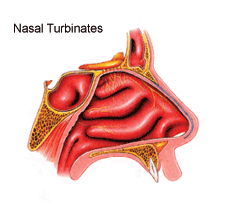What are the turbinates?
- Posted on: May 17 2012
The nasal passages are lined in the middle with what is called the nasal septum. On the side walls on each side, there are three sets of turbinates: The upper (superior), the middle, and the lower (inferior). The turbinates are bony projections with mucous membrane lining that provide additional surface area to the air that we breath. It is believed that turbinates function to modify the air before it reaches our lungs: the air is moisturized, cleaned from any debris, and optimized for temperature.
The inferior turbinate is the largest of the turbinates, and it can be seen by simply looking into the nostrils. Some people have mistaken the inferior turbinates for polyps or other growths within the nasal passages. The inferior turbinates do the majority of the function of the turbinates. If the inferior turbinates are otherwise big and bulky, they can conversely cause quite a bit of obstruction of the nasal passages.
The middle turbinates can only be seen by endoscopy in most cases. They usually cover the sinus drainage pathways, and provide the layer of protection. The superior turbinates are very small, and we are not sure if they serve any function.
During sinus or nasal surgery, it might become necessary for the turbinates to be addressed as well. Typically, when I perform septoplasty to provide additional room for the breathing, I also use a coblation device to shrink the bony component of the inferior turbinates while preserving the integrity of the membranes for future function. The middle turbinates might need to be pushed more towards the center to allow more access for the sinuses to drain more spontaneously.
Quite a few decades ago, the function of the turbinates was not certain. It was common practice to remove portions or entire turbinates in order to make more room for the breathing and for the drainage. The patients who had this kind of surgery subsequently went on to suffer from dryness of the nasal membranes as well as frequent nosebleeds. It is no longer standard practice to remove the turbinates for routine breathing or sinus issues. We now prefer to address the bulkiness of the bony component and preserve the membranes as much as possible in order to have ongoing normal functioning of the turbinates.
Tagged with: breathing, ear nose throat, ENT, Isaac Namdar, Isaac Namdar MD, nasal airway, New York, new york city, Otolaryngology, Otorhinolaryngology, turbinates, turbinectomy
Posted in: Nose


